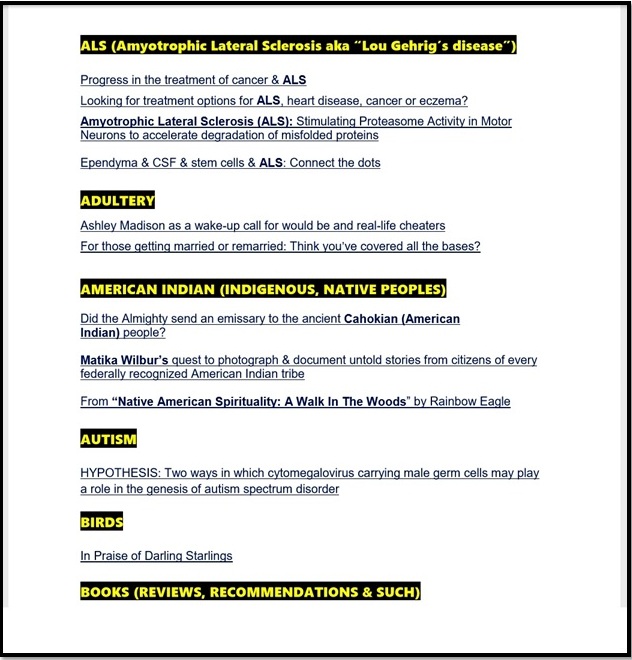Blog Archives
You probably know your IQ and EQ scores (respectively). What about your AS?
Posted by Dr. Anthony G. Payne
https://www.simplypsychology.org/attachment-styles.html – A rundown of the various attachment styles (Simply Psychology website)
What is your attachment style? This interactive survey takes about 5 minutes to complete. The questionnaire is designed to measure your ‘attachment style’–the way you relate to others in the context of intimate relationships. When completed, the site will reveal your attachment style, and provide a brief summary of what is known about your attachment style on the basis of contemporary scientific research.
Posted in EGO write proinde EGO sum, ENJOY YOURSELF, FREE ON-LINE TESTS, MINISTRY OF ENLIGHTENMENT, OP-ED
Comments Off on You probably know your IQ and EQ scores (respectively). What about your AS?
Tags: attachment, attachment styles, EQ, IQ, Online attachment style test, psychology
Your mind as universe & what you can do to change it
Posted by Dr. Anthony G. Payne
 Do you like it when a new way of looking at a situation or phenomenon comes to mind or is introduced to you by someone else? If your answer is “yes” then you probably will enjoy what I am about to share.
Do you like it when a new way of looking at a situation or phenomenon comes to mind or is introduced to you by someone else? If your answer is “yes” then you probably will enjoy what I am about to share.
Back during junior high I was riveted by Einstein’s General Relativity and the unified, very cogent spin it offered on gravitation. Before your eyes glass over rest assured what I have to share does not get into physics but, rather, borrows something from it you will readily understand and (I hope) appreciate.
Einstein described gravity as a geometric property of what is called spacetime. Picture spacetime as a trampoline, and then mentally set a heavy object on its surface, let’s say a bowling ball. What happens? The bowling ball produces an indentation in the trampoline fabric or curvature. This is what the sun and earth and other objects in the universe do to spacetime. If one increases the mass of an object then the curvature increases. This very brief YouTube video does a smashing job of graphically illustrating this: http://www.youtube.com/watch?v=LoaOHvy5AcA
Now I want to analogize this to human psychology. Here is how:
We are all born into this world with anything but a tabula rasa or blank slate. In addition, to built-in brain circuits (modules) that favor survival as well as give rise to and sustain all kinds of behavioral propensities, there is evidence of stored memories including elements of language acquired in utero and emotional and mood wiring at unconscious as well as conscious levels.
Using the spacetime analogy, the trampoline fabric in this instance is affect (mood, emotions and affective logic circuitry) as it animates and informs most non- or un- conscious and conscious brain processes. This fabric is studded with various objects – bowling balls or planets or whatever image tickles your fancy – which are variously non- & un- conscious as well as conscious predispositions, drives, et cetera.
With this picture in mind, let’s say you reach adulthood and spend a great deal of time engaging in helping others, say as a volunteer or medical professional or cleric. This feeds the objects on the trampoline that both feed & inform charity and altruism which grow and by so doing dwarfs other objects (pursuits, needs, desires, etc.) and eventually produces enough deformation in the fabric to bring smaller nearby objects into orbit (or subjugation, as it were). The same process is true of people who, say, feed their sexual appetite or conversely, starve it (Perhaps 20% or more of marriages in the US are sexless according to some experts. While this may reflect large numbers of people with attachment or other personality disorders, it may so reflect neglect of one dimension or object in the sexual constellation of self and the feeding of others, say cyber-fantasies).
So of what real world good is there in knowing this? In-a-word your universe consists of objects whose size and influence reflects your focus or conversely neglect. So if you something is wrecking your peace or that of your marriage or professional life, sketch out your universe and see which aspects (objects) are being overfed or underfed. Then focus on shrinking or conversely growing them.
How to do this? It really is simple but this is not to say easy. Change your behavior,… your conduct. The rest of you will follow suit if you do so and stick with it.
Don’t believe remodeling your personal universe can be done in this way? Go to Amazon or whatever shopping website you prefer and search out “Strangers to Ourselves” (subtitled “Discovering the Adaptive Unconscious”) by Dr. Timothy D. Wilson (Sherrell J. Aston Professor of Psychology at the University of Virginia). If you are in a rush after receiving this insightful tome, turn to chapter 10 and read it in its entirety.
TO READ MORE ON ATTACHMENT DISORDERS GO TO http://bit.ly/Xjqsja
SUPPLEMENTAL READING:
University of Pennsylvania Dorothy Swaine Thomas Professor in Sociology Dr. Randall Collins classic work “Interaction Ritual Chains” (Princeton Studies in Cultural Sociology)
From a review of Dr. Collins seminal work by Gary Alan Fine that appeared in Social Forces Volume 83, Number 3, March 2005 pp. 1287-1288 | 10.1353/sof.2005.0029
“Simply put, Collins argues that interaction rituals produce emotional energy, the gathering of which is a central motivating force for individuals. Affect is the engine of social order. Those interaction rituals that are most effective in generating emotional energy are the ones that bolster institutional stability. We seek emotional energy the way that felines seek catnip—it gives us a buzz. Collins stands athwart the cognitive turn in social psychology, finding affect where others find thought, and indeed valuably devotes a chapter to demonstrating the various ways in which thinking must be linked to emotional entrainment.”
https://muse.jhu.edu/login?auth=0&type=summary&url=/journals/social_forces/v083/83.3fine.html
AFFECTIVE LOGIC: http://affect-logic.com/5.html
EXTENDED BEING: http://extendbeing.weebly.com/
© 2013 by Dr. Anthony G. Payne. All rights reserved.
Posted in EGO write proinde EGO sum, NEUROPHILOSOPHY, Psychology
Comments Off on Your mind as universe & what you can do to change it
Tags: adaptive unconscious, affect, affective circuits, affective logic, attachment, attachment disorders, Choctaw Doc, cultural sociology, Discovering the Adaptive Unconscious, Einstein, extended being, Freud, General Relatively, gravitation, gravitons, gravity, gravity waves, Interaction Ritual Chains, nonconscious, preconscious, psychotherapy, Randall Collins, sexless, spacetime, tabula rasa, Timothy D. Wilson, unconscious







